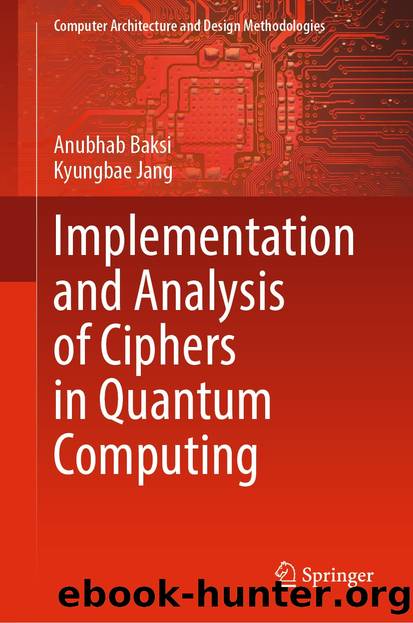Implementation and Analysis of Ciphers in Quantum Computing by Anubhab Baksi & Kyungbae Jang

Author:Anubhab Baksi & Kyungbae Jang
Language: eng
Format: epub
ISBN: 9789819700257
Publisher: Springer Nature Singapore
6.3.2 Shallow Version and Shallow/Low Depth Version
We propose a shallow version in which all possible parts of AES quantum circuits operate, simultaneously. When S-box with Toffoli depth 4 is used, this can be achieved by using 2 sets of ancilla qubits. In the shallow version, the first SubBytes in Fig. 6.4b uses the first ancilla qubits. The second SubBytes uses the second ancilla qubits, and at the same time SubBytes cleans the first ancilla qubits. That is, SubBytes operates simultaneously with the SubBytes of the next round. Conceptually, this can be thought as all SubBytes in Fig. 6.4a are pushed one space to the right. This is possible because SubBytes and SubBytes do not share any ancilla qubit. Thanks to this parallel structure (using 2 alternative ancilla sets), the shallow version counts the depth for one round as SubBytes (72) + MixColumns (28), which is the ideal depth. The circuit depth of AESâ128 is 960 (about 9 rounds 100 72), that of AESâ192 is 1152 (about 11 rounds 100 72), and the same for AESâ256 is 1351 (about 13 rounds 100 72). In the shallow version, up to SubBytes operates concurrently within one round, providing maximum parallelism. Finally, the shallow version (â) offer the least Toffoli depth (â¦) of the S-box âs Toffoli depth rounds, Toffoli depth qubit count (⦠â), and Toffoli depth qubit count (⦠â).
The shallow/low depth version replaces only the MixColumn implementation from the shallow version to a MixColumn which is a courtesy of [92]. As described in Sect. 6.â2.â7, by sharing ancilla qubits of SubBytes, only output qubits are required for any MixColumn implementation in Table 6.3. For this reason, in the shallow/low-depth version (using out-of-place MixColumn), implementing the lowest-depth MixColumn is optimal regardless of the required number of qubits. The low depth version counts the depth for one round as SubBytes (72) + MixColumns (11). The low depth version of AES (â¡) offers the least Toffoli depth (â¦), full depth (â), full depth total gates (metric to estimate quantum attack cost, â â), and full depth qubit count (â â).
Fig. 6.3Zig-zag architecture for AESâ128 quantum circuit
Download
This site does not store any files on its server. We only index and link to content provided by other sites. Please contact the content providers to delete copyright contents if any and email us, we'll remove relevant links or contents immediately.
| Automotive | Engineering |
| Transportation |
Whiskies Galore by Ian Buxton(41707)
Introduction to Aircraft Design (Cambridge Aerospace Series) by John P. Fielding(33011)
Small Unmanned Fixed-wing Aircraft Design by Andrew J. Keane Andras Sobester James P. Scanlan & András Sóbester & James P. Scanlan(32678)
Craft Beer for the Homebrewer by Michael Agnew(18071)
Turbulence by E. J. Noyes(7886)
The Complete Stick Figure Physics Tutorials by Allen Sarah(7257)
Kaplan MCAT General Chemistry Review by Kaplan(6809)
The Thirst by Nesbo Jo(6747)
Bad Blood by John Carreyrou(6466)
Modelling of Convective Heat and Mass Transfer in Rotating Flows by Igor V. Shevchuk(6347)
Learning SQL by Alan Beaulieu(6151)
Weapons of Math Destruction by Cathy O'Neil(6072)
Man-made Catastrophes and Risk Information Concealment by Dmitry Chernov & Didier Sornette(5864)
Digital Minimalism by Cal Newport;(5575)
Life 3.0: Being Human in the Age of Artificial Intelligence by Tegmark Max(5393)
iGen by Jean M. Twenge(5292)
Secrets of Antigravity Propulsion: Tesla, UFOs, and Classified Aerospace Technology by Ph.D. Paul A. Laviolette(5231)
Design of Trajectory Optimization Approach for Space Maneuver Vehicle Skip Entry Problems by Runqi Chai & Al Savvaris & Antonios Tsourdos & Senchun Chai(4948)
Electronic Devices & Circuits by Jacob Millman & Christos C. Halkias(4859)
